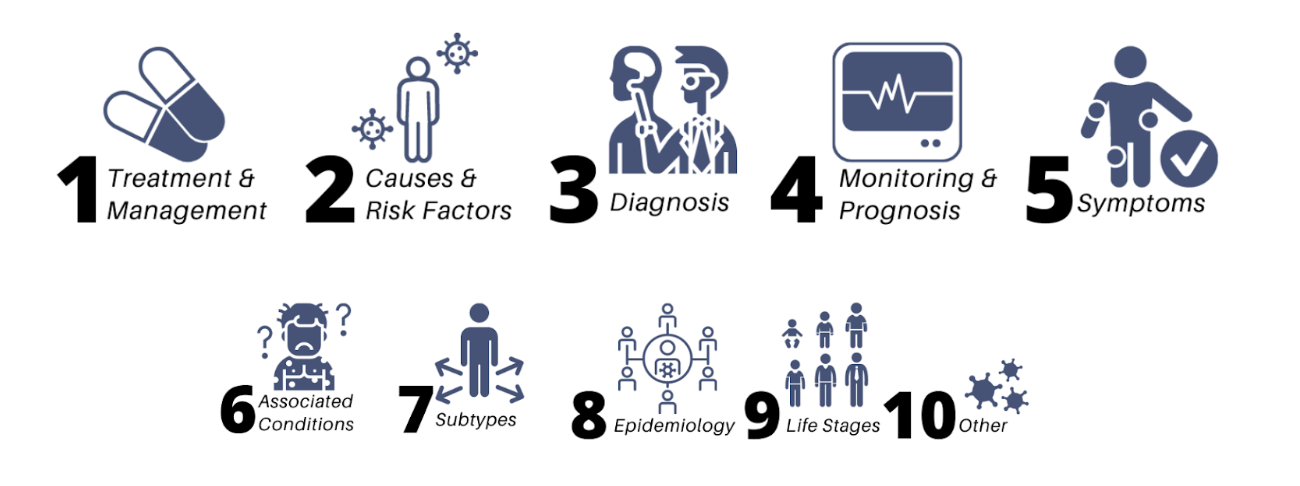All In Movement Project
The Castleman Disease Collaborative Network (CDCN) has made great strides in increasing understanding of the unknowns of Castleman disease. However, there is still so much progress to be made before all patients are living full lives. The CDCN’s ‘All In’ Movement 2021 (AIM 2021) allowed us to crowdsource and prioritize questions from the entire Castleman disease community to guide the next generation of research studies on Castleman disease.
The goal of this project was to generate a list of high priority studies to focus research efforts. Our aim was to have at least 50 questions about Castleman disease generated by the Castleman disease community, which the community would then vote to prioritize. The submitted questions would then be reviewed by the CDCN Scientific Advisory Board to plan studies that answer the unknowns of Castleman disease. These prioritized studies would then have funds raised and researchers identified for execution.
Phases:
The All In Movement (AIM 2021) is the CDCN’s initiative to gather and prioritize questions about CD and its impact on patients from the CDCN community to drive the next generation of high-impact studies. There are seven phases of this initiative, five key phases for our community to engage in: Launch, Idea Submission, Data Analysis, Voting, Data Analysis, SAB Review and Research Execution.
Results:
There was strong community participation, with 48 individuals participating in both the idea submission and voting stage. A total of 155 ideas/questions were submitted. Our team grouped the 155 ideas/questions into 10 broad research categories and 69 condensed ideas/questions. In the voting phase, 48 individuals participated, casting a total of 1086 votes.

Tier 1 (Top 3) Research Questions:
- Is JAK inhibition an effective treatment for iMCD patients refractory to siltuximab and sirolimus?
- What treatment options are available for patients who have a failed or incomplete response to anti-IL6 therapy?
- What biomarkers can be used to improve diagnosis and tracking (preventing relapse) of iMCD (ex: sFLT-1)?
Tier 2 (Top 4-9) Research Questions:
- Why don’t all iMCD patients respond to anti-IL6 therapy?
- How long should a patient remain on CD treatment (such as siltuximab or sirolimus)? What are recommendations for treatment spacing? Can doses be spaced further apart or discontinued? Can the route of administration be changed?
- What biomarkers can be used to predict a high likelihood of treatment response in individual patients?
- Besides IL-6, what circulating or lymph node cytokines, cytokine receptors, and cell-signaling pathways are involved in Castleman disease? Can these cytokines/pathways be targeted with therapies?
- What circulating or lymph node cell types are responsible for Castleman disease and/or contributing to key elements of Castleman disease(e.g., IL-6 production, increased mTORC1 activation)?
- What are the indicators/predictors of iMCD relapse ?
Tier 3 (Top 10-20) Research Questions:
- What are effective treatment approaches for unresectable UCD?
- Are somatic (potentially cancer-causing) mutations in circulating immune cells or rare lymph node populations responsible for iMCD?
- What are the risks of long term CD treatment (ex: malignancies, autoimmune diseases, etc.)? Is there any way of reducing side effects?
- Is CD genetic/hereditary? Are there genetic variants, mutations, or HLA types associated with CD in constitutional DNA? If so, could it be amenable to gene therapy?
- How can we identify new therapeutic targets and treatment options for anti-IL-6 non-responders?
- What is the lasting psycho-emotional impact of CD (ex: PTSD-like symptoms)? How can we provide adequate supportive care to CD patients to improve quality of life?
- What are the specific risks for lymphoma and other associated diseases? Should Castleman patients be screened?
- Is there an association with having a family history of other autoimmune conditions (diabetes, Hashimoto’s/autoimmune thyroiditis, rheumatoid arthritis, multiple sclerosis (MS), lupus, or myasthenia gravis?
- Can CD be activated by pregancy-related autoimmune phenomena? What are the effects of CD on pregnancy and risk of miscarriage?
- Does CD diagnosed in childhood and adolescence have the same causes and risk factors as CD in adults? How should CD be treated or managed in childhood and adolescence?
- What are the treatment options for non-recectable UCD in children and young adults?
If you have questions about this project or its results, please contact Mileva at mileva@castlemannetwork.org or (610) 304-0696.
